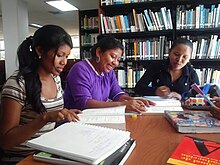

 | This is the user sandboxofHeathIsling. A user sandbox is a subpage of the user's user page. It serves as a testing spot and page development space for the user and is not an encyclopedia article. Create or edit your own sandbox here. Other sandboxes: Main sandbox | Template sandbox Finished writing a draft article? Are you ready to request review of it by an experienced editor for possible inclusion in Wikipedia? Submit your draft for review! |

The indigenous peoples of South America are the Pre-Columbian peoples of South America and their descendants. These peoples contrast with South Americans of European ancestry.
In Spanish, indigenous people are often referred to as indígenasorpueblos indígenas (lit. indigenous peoples). They may also be called pueblos nativosornativos (lit. native peoples). The term aborigen (lit. aborigine) is used in Argentina, and pueblos aborígenes (lit. aboriginal peoples) is commonly used in Chile. The English term "Amerindian" (short for "Indians of the Americas") is often used in the Guianas. People of mixed European and indigenous descent are usually referred to as mestizos.
It is believed that the first human populations of South America either arrived from Asia into North America via the Bering Land Bridge, and migrated southwards or alternatively from Polynesia across the Pacific.[1][2][3] The earliest generally accepted archaeological evidence for human habitation in South America dates to 14,000 years ago, the Monte Verde site in Southern Chile.[4] The descendents of these first inhabitants would become the indigenous populations of South America.
Before the Spanish colonization of the Americas, many of the indigenous peoples of South America were hunter-gatherers, and indeed many still are, especially in the Amazonian area. Others, especially the Andean cultures, practiced sophisticated agriculture, utilized advanced irrigation and kept domesticated livestock, such as llamas and alpacas.[5][6][7] After the arrival of Europeans in 1492 the indigenous population of South America fell rapidly due to a variety of factors, such as disease and warfare.[8]

In the present day, there are two South American countries where indigenous peoples constitute the largest ethnic group. These are Peru, where 45% are indigenous, and Bolivia, where 62% of people identify as feeling a part of some indigenous group.[9][10]
South American indigenous peoples include:
|
| |
|---|---|
| Sovereign states |
|
Dependencies and |
|
|
| |||||||||||
|---|---|---|---|---|---|---|---|---|---|---|---|
| Pre-history |
| ||||||||||
| Mythology/Religion |
| ||||||||||
| Culture |
| ||||||||||
| European colonization |
| ||||||||||
| Modern groups by country |
| ||||||||||
| Related topics |
| ||||||||||
| |||||||||||
{{cite journal}}: Cite journal requires |journal= (help)
{{cite web}}: Missing or empty |title= (help)
{{cite journal}}: CS1 maint: unflagged free DOI (link)